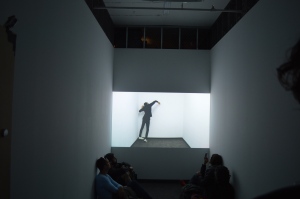Below is an interview with performer Kelly Keenan on the topic of her participation
in the performance We can make this work.
AK: First of all, I wonder if you could just tell me what made you decide to
participate in We can make this work?
KK: As a friend and colleague, I was already inclined to participate but essentially
your writing on the website, which helped me to understand your motivation in
more depth, excited me to accept this invitation to perform with you. I wrote the
cheque immediately.
AK: When you decided to participate, did you find it difficult to resolve to
actually send money?
KK: Yes, not because of lack of trust but because of my account being deflated and I
was waiting for pay to come in. If you remember, I told you to wait for my “cue” to
cash the cheque.
AK: What was it like to participate?
KK: It was fun. I made a sub-performance out of it where I filmed the writing of the
cheque from photobooth. Photobooth (Mac Software) films backwards so it then
became funny to me that the cheque I wrote appeared to be for $001. In any case
the amount seemed irrelevant. The participation, action and transaction seemed
to be the important matter.
AK: I assume that you frequently send money to various people. Did this
instance of sending money seem or feel different? Why?
KK: It was different in the sense that I knew that 99% would come back and I don’t
normally get money back after I send it unless I request a refund. The return of
the money, the collaboration, was in fact what I was purchasing.
AK: Describe the feeling of receiving the return cheque. Did it feel different from
a normal instance of receiving money?
KK: There is a certain pleasure in receiving a cheque. It’s like getting a
postcard or a tax credit you forgot about in the mail. It’s a pleasant moment in the day.
There is another pleasure in cashing a cheque. As a resourceful person I see a
lot of potential in $99. I did nothing extraordinary with the return cheque. I must
have paid a bill and the rest got lumped with my previous account balance. In
retrospect I wish I had done something a little special with this cheque.
It’s art isn’t it? Should I have framed it? You are very likely to be famous one
day. Maybe that cheque would be worth $9900 in my lifetime.
It was a unique and special exchange with a dear friend. Maybe I should have
put it in my box of mementos.
Not cashing it would have maintained my cheque as a donation to your artistic
practice which in turn is my profit as I enjoy your work so much.
Or perhaps it would enable you to engage collaborators like me. However, I cashed
it, and like a dance, the choreography ended and is now in the archives of
reminiscent memory in the ephemeral.
AK: Has your participation had any lasting effects?
KK: Hydro Quebec still likes me.
AK: Do you feel that trust was an integral part of the piece? Why or why not?
KK: I already trusted you and had no doubt of your reliability. However, this existing
trust was already based on your performance in our previous interactions. I
imagine for those that don’t know you there would be more consideration of
whether you were trustworthy, whether the 99% would actually be returned. In
that case, are your collaborators participating for the thrill of risk entailed? Or
jumping at the invitation to trust others?
To be honest, had I not known you, given the low balance of my bank account at
that time, I likely would not have participated. There are appropriate and
inappropriate times to gamble.
AK: Part of the idea of we can make this work is to rob money of its
performative power—that is, its power to create social reality. Can you
reflect on this intention having participated in the piece?
KK: In my role of giving you a cheque was an act to willfully engage in a creative
social proposition and exchange. In your case, the invitation actively seeks social
exchange with a limitless and indiscriminate number of participants. Maintaining
your performed promise by handing me a return cheque of 99% was an act that
affirmed your social credibility and reliability from my perspective and, I presume,
also of the other collaborators whom you honored your agreement to.
So, I am not yet convinced the money was robbed of its power to create social
reality.
Can it be that “we can make this work” in fact suggests a social reality? A positive
and creative social reality encouraging exchange, honorability and no one
gravely loses.
Can it be that “we can make this work” infact builds your personal social reality?
However, in the sense that due to the almost exact equal amount exchanged the
transaction becomes trivial and thus, yes, powerless.





